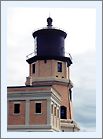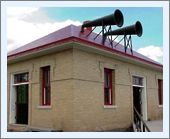|
Historical information

The north shore of Superior has always been a hazardous area to
mariners. Sluggish compass reaction combined with huge deposits of iron
in the rocks along the shore play havoc with navigation. Nowhere is this
variation greater than along the shoreline between Two Harbors and
Beaver Bay where mariners are warned in the Great Lakes Coast Pilot to
expect total compass deviations of 2.2 degrees, with many a mariner
ending up on the rocks while making his way along the north shore at
night. Combine this magnetic aberration with a major storm, and you have
a natural recipe for disaster. Such was the case in 1905, when a series
of back to back storms between November 27th and 29th
whipped the big lake into a froth, causing the loss or damage of 29
vessels and over 200 associated deaths.
The cry for a light in the area from the maritime community was
immediate, and with the addition of pressure applied by the Lake Carrierís
Association, Congress passed a resolution approving the establishment of
the new station on February 26, 1907, and quickly followed up with a
$75,000 appropriation for construction on March 4 of that same year
A survey party was dispatched to the area, and selected a 7.63
acre-parcel of land between Two Harbors and Beaver Bay at the upper edge
of a 127-foot tall cliff known locally as Stony Point. While the site
selected for the station was atop Stony Point, for some reason the
Lighthouse Board named the station after Split Rock River, three miles
to the southwest.
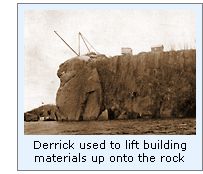 Negotiations for purchase of the site began immediately, however
after a year of negotiations, no arrangements were forthcoming.
Evidently the owner had a change of heart after District Engineer Major
Charles Keller instituted condemnation proceedings on the property, and
with clear title in hand late in 1908, Lighthouse Engineer Ralph Russell
Tinkham drew up plans and specifications for the new station. Material
contracts were awarded to a number of suppliers, and the contract for
supplying the 30 to 50 men required to do the actual construction
awarded to L. D. Campbell & Son of Duluth. With the planning phase
complete, work began at the site in June 1909. With no roads servicing
the area the construction crew was forced to transport all materials to
the site by water. Fortunately, the water depth at the bottom of the
cliff was sufficient to allow vessels to pull close to the cliff face,
and a timber derrick was erected atop the cliff. Outfitted with a
hoisting engine, the derrick was swung out over the cliff face, and all
materials required for construction were hauled to the top. Negotiations for purchase of the site began immediately, however
after a year of negotiations, no arrangements were forthcoming.
Evidently the owner had a change of heart after District Engineer Major
Charles Keller instituted condemnation proceedings on the property, and
with clear title in hand late in 1908, Lighthouse Engineer Ralph Russell
Tinkham drew up plans and specifications for the new station. Material
contracts were awarded to a number of suppliers, and the contract for
supplying the 30 to 50 men required to do the actual construction
awarded to L. D. Campbell & Son of Duluth. With the planning phase
complete, work began at the site in June 1909. With no roads servicing
the area the construction crew was forced to transport all materials to
the site by water. Fortunately, the water depth at the bottom of the
cliff was sufficient to allow vessels to pull close to the cliff face,
and a timber derrick was erected atop the cliff. Outfitted with a
hoisting engine, the derrick was swung out over the cliff face, and all
materials required for construction were hauled to the top.
After establishing a working camp atop the cliff, the crew began
blasting foundations for the station buildings. Plans called for the
lighthouse and fog signal building to be erected on a single large
concrete foundation, and the three dwellings to be located in a row to
the north. By July, all of the required construction materials had been
received, and either transported to the site, or in storage at the
Detroit lighthouse depot in readiness for shipment. With winterís icy
grip falling over the north Superior coast, work at the site ended on
November 21, 1909, and the work crews left for home.
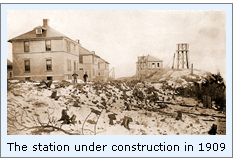 The contractors returned to Spilt Rock on May 1, 1910, and were
elated to find that their work of the previous year had withstood the
rigors of the Lake Superior winter. The new Second Order Fresnel lens
was received at the Detroit lighthouse depot on May 20, and soon
thereafter the lens and the mechanical equipment for the fog signal
building were loaded on the lighthouse tender AMARANTH, and delivered at
the station. The construction crews evidently worked at a feverish pace
over the spring and summer, since by the end of June the fog signal
building was complete, the steel support framework for the tower had
been erected, and work was almost complete on the erection of the three
keepers dwellings. Work was finally brought to completion, and the new
light exhibited for the first time on the night of August 1, 1910. The contractors returned to Spilt Rock on May 1, 1910, and were
elated to find that their work of the previous year had withstood the
rigors of the Lake Superior winter. The new Second Order Fresnel lens
was received at the Detroit lighthouse depot on May 20, and soon
thereafter the lens and the mechanical equipment for the fog signal
building were loaded on the lighthouse tender AMARANTH, and delivered at
the station. The construction crews evidently worked at a feverish pace
over the spring and summer, since by the end of June the fog signal
building was complete, the steel support framework for the tower had
been erected, and work was almost complete on the erection of the three
keepers dwellings. Work was finally brought to completion, and the new
light exhibited for the first time on the night of August 1, 1910.
On completion, the lighthouse itself consisted of a pyramidal
octagonal Cream City brick tower with concrete trim atop a concrete
foundation which extended 2 feet six inches into the rock. The tower was
surmounted by a brick watch room and a cast iron lantern with vertical
astragals. Within the tower, a cylindrical glazed white brick lining
housed a set of spiral cast iron steps which provided access to the
watch room and thence to the lantern above. A structural steel framework
sandwiched between the inner and outer walls provided the structure with
the immense strength needed to withstand the heavy wind loads predicted
on the stations lofty perch. A combination cleaning room and office was
attached to north side of the tower by a short passageway.
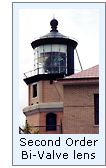 Seated majestically in the lantern, the Parisian-manufactured
Second
Order Fresnel lens was of "bi-valve" design, so called due to
its resemblance to a mollusk shell. Consisting of two large panels made
up of 7 refracting prisms and 13 reflecting prisms each, the entire
assembly floated on a bed of liquid mercury to minimize rotational
friction. A clockwork mechanism once every 20 seconds, providing the
stationís planned characteristic of a single white flash every 10
seconds. The lens was illuminated by a 55-millimeter double tank
incandescent oil vapor lamp, providing a remarkably bright light of
1,200,000 candlepower. By virtue of the towerís location atop the
cliff, the lens boasted an impressive 168-foot focal plane, and was
visible for a distance of 22 miles in clear weather condition. Seated majestically in the lantern, the Parisian-manufactured
Second
Order Fresnel lens was of "bi-valve" design, so called due to
its resemblance to a mollusk shell. Consisting of two large panels made
up of 7 refracting prisms and 13 reflecting prisms each, the entire
assembly floated on a bed of liquid mercury to minimize rotational
friction. A clockwork mechanism once every 20 seconds, providing the
stationís planned characteristic of a single white flash every 10
seconds. The lens was illuminated by a 55-millimeter double tank
incandescent oil vapor lamp, providing a remarkably bright light of
1,200,000 candlepower. By virtue of the towerís location atop the
cliff, the lens boasted an impressive 168-foot focal plane, and was
visible for a distance of 22 miles in clear weather condition.
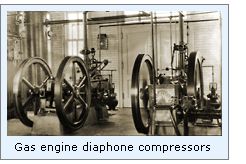 Approximately forty feet to the east of the tower, the fog signal was
constructed of the same Cream City brick as the tower. Located on a
single bed within the building, a pair of 22-horsepower gasoline engines
drove two large compressors which supplied compressed air to the
duplicate Type 2-T diaphone fog signals with their large trumpet-shaped
resonators protruding from the lakeward side of the building in order to
project their sound five miles across the lake. The "2-T"
designation for the diaphones indicated that they were of
"two-tone" design, providing the quintessential melancholy
"Bee-Oh" sound every 20 seconds. The fog signal was so loud
that it reportedly made horses skittish five miles away in Beaver Bay,
and caused guests at Slater's Hotel to ask what wild animal were making
such a racket. Approximately forty feet to the east of the tower, the fog signal was
constructed of the same Cream City brick as the tower. Located on a
single bed within the building, a pair of 22-horsepower gasoline engines
drove two large compressors which supplied compressed air to the
duplicate Type 2-T diaphone fog signals with their large trumpet-shaped
resonators protruding from the lakeward side of the building in order to
project their sound five miles across the lake. The "2-T"
designation for the diaphones indicated that they were of
"two-tone" design, providing the quintessential melancholy
"Bee-Oh" sound every 20 seconds. The fog signal was so loud
that it reportedly made horses skittish five miles away in Beaver Bay,
and caused guests at Slater's Hotel to ask what wild animal were making
such a racket.
The three identical brick keepers dwellings sat in a row to the north
of the lighthouse. Each on its own cellar containing a water cistern and
cold storage, their first floors provided a hall, living room, dining
room and kitchen, and their second floors three bedrooms and a bath. A
main concrete walkway lead from the lighthouse in front of the
dwellings, each with its own walkway branching off the main walk at a
crisp 90į angle. Each dwelling was provided
with its own barn across the main walkway for the keeperís horses and
feed.
A log crib pier was erected on a rocky beach area approximately 1,000
feet to the west of the station, with access gained by a long timber
stairway which hugged the rock face at an area where the slope was a
little less severe. A wood framed boat house situated beside the pier
provided storage for the keeperís boats, which the used for
transporting small supplies to the station, and for fishing trips along
the fertile lakeshore. Under a special separate appropriation, a
concrete oil storage building was erected at the station late in 1910,
to allow the storage of kerosene a safe distance from the main station
buildings.
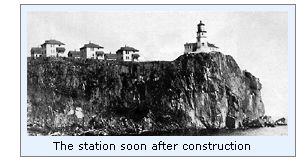 All told, the station was completed for a total cost of $72,541.00,
which was $2,459.00 below the appropriation made three years earlier,
and amazing feat when one considers the logistical problems associated
with construction at such a difficult and remote location. All told, the station was completed for a total cost of $72,541.00,
which was $2,459.00 below the appropriation made three years earlier,
and amazing feat when one considers the logistical problems associated
with construction at such a difficult and remote location.
A seasoned Head Keeper was needed to take charge of the new station,
and Orrin "Pete" Young fit the bill perfectly. Fifty-two years
of age, Young had entered lighthouse service as Second Assistant at
Huron Island in 1901. Promoted to First Assistant in early 1903, he
accepted a transfer to Grand Island East in 1908, in which capacity he
had been serving for the past two years. The offer of a promotion as
Head Keeper of a new first-class coast light station would have been an
enviable offer, and it is no surprise that Young accepted the promotion,
arriving at the new station to take command on July 20, 1910.
First Assistant Keeper Edward F. Sexton had hired in at Devils Island
as Second Assistant in April 1910, and arrived at Split Rock on August
31. With the arrival of Second Assistant Roy C. Gill, the station roster
was complete. Gill had served as Second Assistant at Huron
Island, and
he and Young likely had the opportunity to swap a few stories about
their time the island. In the early days, the station was considered so
remote that it may as well have been located on an island. While the
area around the lighthouse had been clear-cut to ensure a full arc of
visibility of the light, thick virgin forest spread beyond the
lighthouse grounds in all directions. With Lake Superior as the only way
on or off the rock, the stationís mail was delivered to a lumber camp
at the mouth of the Split Rock River, which was considered by Duluthians
to be the eastern extent of civilization on the north shore.
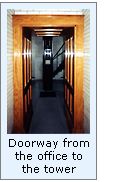 On Sunday October 2, 1910, Assistants Sexton and Gill left the
station at 12.30 p.m. in the stationís small rowboat on such a mail
run. While Keeper Young was understandably concerned when his Assistants
had not returned by nightfall, he was unable to leave the light
unattended until the following morning, when he set out at 8.00 a.m. on
another boat to search for them. He quickly discovered the empty boat
floating bottom-up two miles to the east of the station. Faced with the
realization that that both of his Assistants had likely drowned, Young
searched the area for their bodies to no avail. Needing to return to the
station before dusk to exhibit the light, Young was forced to abandon
the search, and towed the Assistantís boat back to the station. On
returning to the station, Young found the boatís boom had been lashed
to the seat. A consummate sailor, Young knew better than to lash the
boom, since without a keel the rowboat could easily be blown over in a
stiff wind were the boom not allowed to swing free. While Young reported
in the station log book that he searched for the bodies every day for
the following two weeks, they were never found. On Sunday October 2, 1910, Assistants Sexton and Gill left the
station at 12.30 p.m. in the stationís small rowboat on such a mail
run. While Keeper Young was understandably concerned when his Assistants
had not returned by nightfall, he was unable to leave the light
unattended until the following morning, when he set out at 8.00 a.m. on
another boat to search for them. He quickly discovered the empty boat
floating bottom-up two miles to the east of the station. Faced with the
realization that that both of his Assistants had likely drowned, Young
searched the area for their bodies to no avail. Needing to return to the
station before dusk to exhibit the light, Young was forced to abandon
the search, and towed the Assistantís boat back to the station. On
returning to the station, Young found the boatís boom had been lashed
to the seat. A consummate sailor, Young knew better than to lash the
boom, since without a keel the rowboat could easily be blown over in a
stiff wind were the boom not allowed to swing free. While Young reported
in the station log book that he searched for the bodies every day for
the following two weeks, they were never found.
Young sent word to the Detroit office of the death of both of his
Assistants, requesting the appointment of replacements as soon as
possible. Sadly the late First Assistant Sextonís pregnant wife and
young child left the station on October 6 on a motor launch dispatched
to pick them up from Two
Harbors.
Lee Benton was selected as Youngís new First Assistant. A
thirty-two year old with five years experience as Assistant at Devils
Island, Benton reported for duty at Split Rock on October 15. Second
Assistant James W. Taylor, a freshman with only two years of lighthouse
service under his belt at Point Iroquois and Duluth arrived from Duluth
three days behind Benton on the October 18.
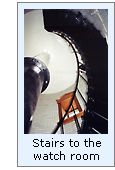 After a few years, the derrick used for lifting supplies to the
station proved to be hazardous and cantankerous, and the lighthouse
tender AMARANTH arrived at the station in the fall of 1915 to deliver a
Lighthouse Service engineer and German carpenter and materials to erect
an elevated tramway alongside the stairway leading down to the pier. The
tramway was completely constructed of steel reinforced concrete, poured
into wooden forms erected on site. Supported by concrete trestles, a
pair of iron tracks lead from the water edge to a the top of the bluff.
A small car with flanged wheels and a horizontal upper surface was
pulled up and down the rails by way of a gasoline engine located within
a small hoist house at the top of the bluff. An iron turntable on flat
ground in front of the hoist house allowed the car to be disconnected
from the cable, rotated and switched onto a second set of rails which
lead to the dwellings and oil storage building. The work was completed
in 1916, and the old derrick removed from the cliff top. After a few years, the derrick used for lifting supplies to the
station proved to be hazardous and cantankerous, and the lighthouse
tender AMARANTH arrived at the station in the fall of 1915 to deliver a
Lighthouse Service engineer and German carpenter and materials to erect
an elevated tramway alongside the stairway leading down to the pier. The
tramway was completely constructed of steel reinforced concrete, poured
into wooden forms erected on site. Supported by concrete trestles, a
pair of iron tracks lead from the water edge to a the top of the bluff.
A small car with flanged wheels and a horizontal upper surface was
pulled up and down the rails by way of a gasoline engine located within
a small hoist house at the top of the bluff. An iron turntable on flat
ground in front of the hoist house allowed the car to be disconnected
from the cable, rotated and switched onto a second set of rails which
lead to the dwellings and oil storage building. The work was completed
in 1916, and the old derrick removed from the cliff top.
With the construction of North Shore Highway past the station in
1924, the stationís isolation vanished immediately, as growing numbers
of tourists took the drive from Duluth to visit the station. Light
keepers were mandated to "be courteous and polite to all visitors
and show them everything of interest about the station at such times as
will not interfere with light-house duties." However, it is likely
that in this respect the Split Rock Keepers were challenged highly. In
1936 alone, 30,000 visitors signed the stationís visitor log, and it
is hard to imagine how they were able to keep up with such an influx of
visitors.
With the installation of commercial electric power along the North
Shore Highway in 1941, the station was electrified in 1941. With
electrification, the incandescent oil vapor lamp illuminating the
Fresnel lens was removed, and replaced by an incandescent electric bulb,
with a decrease in intensity of the light to 450,000 candlepower.
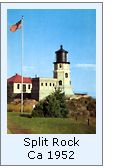 Advances in RADAR and LORAN-C rendered the lighthouse obsolete, and
thus the station was closed and the light permanently extinguished in
1969. The Minnesota Historical Society obtained ownership of the
property in 1971, and operates the station as a living museum, with the
structures restored to their pre 1924 appearance. Lee Radzak today
serves as full-time keeper, who along with a number of live-in docents
give tours of the station and presentations on the history of the
station throughout the Great Lakes. Advances in RADAR and LORAN-C rendered the lighthouse obsolete, and
thus the station was closed and the light permanently extinguished in
1969. The Minnesota Historical Society obtained ownership of the
property in 1971, and operates the station as a living museum, with the
structures restored to their pre 1924 appearance. Lee Radzak today
serves as full-time keeper, who along with a number of live-in docents
give tours of the station and presentations on the history of the
station throughout the Great Lakes.
Each year the Lighthouse marks the anniversary of the loss of the
Edmund Fitzgerald with a public program that includes a reading of the
names of the 29 men who lost their lives on the Fitzgerald on November
10th, 1975. The lighthouse, normally closed during the winter, is
reopened for this one day event and the beacon is lighted at dusk.
Hundreds of visitors have attended this event each year since the
ceremony was started in 1985 on the tenth anniversary of the sinking of
"the Big Fitz."
This program provides a once a year opportunity for visitors to be
inside the lighthouse after dark with the beacon again sending its
warning across the dark depths of Lake Superior.

Keepers of
this Light

Click here
to see a complete listing of all Split Rock Light keepers compiled by
Phyllis L. Tag of Great Lakes Lighthouse Research.

Seeing this Light

We had been longing to get to see Split Rock since we saw our first
picture a number of years ago, and thus it became the main destination
of our 1999 lighthouse hunting expedition.
It turned-out to be everything we had hoped it would be. We almost
missed our first glimpse of the lighthouse through the trees, about a
mile east of the rock. We made a quick turn around, and pulled off the
road to eat the lunch we bought in Two Harbors with the view as seen in
the photograph to the left.
Driving on, we entered Split Rock Park, and wandered the grounds. The
entire interior of the tower and the attached building is finished in a
shiny white ceramic-coated brick and natural oak woodwork. The entire
complex has been meticulously restored, and costumed docents make
themselves available to answer questions.
One can get down to the water by way of 174 steps, which are located
alongside the old tramway, which was used for pulling supplies to the
light station from a dock on the shore. The view from the Lake is
breathtaking.
The trees on the grounds were laden with berries. and the air was thick
with cedar waxwings which were making a feast of the bright red fruit.

Finding this
Light

Take Hwy 61 Northeast along the shore of Lake Superior through Two
Harbors and on to Split Rock Lighthouse State Park. Keep an eye out for
the view of the lighthouse approximately 1/2 mile West of the park
entrance. The park entrance is on the right, and all roads in the park
are paved. There is plenty of parking, but the lot gets filled quickly
around Holiday weekends. Entrance to the lighthouse and grounds is
gained through the Visitors Center at the rear of the parking area.

Contact
information
Minnesota Historical Society - Split Rock
3713 Split Rock Lighthouse Rd.
Two Harbors, MN 55616
(218) 226-6372

Reference
Sources

Annual reports of the Lighthouse
Board, 1906 - 1909
Annual reports of the Lake Carrier's Association, various, 1908 -
1940
Great Lakes Light List, 1917
Personal visit to Split Rock on 09/05/1999
Keeper listings for this light appear courtesy of Great
Lakes Lighthouse Research
|

